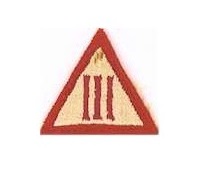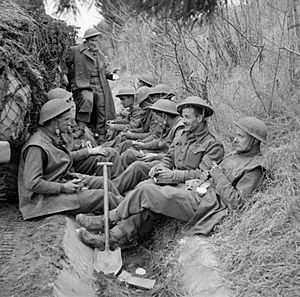3rd Infantry Brigade (United Kingdom) facts for kids
Quick facts for kids 3rd Infantry Brigade |
|
|---|---|

Badge of the 3rd Infantry Brigade.
|
|
| Active | 1809–1981 1988–2004 |
| Country | |
| Branch | |
| Type | Infantry |
| Size | Brigade |
| Part of | HQ Northern Ireland |
| Garrison/HQ | Drumadd Barracks, Armagh |
| Engagements | Peninsular War Second Anglo-Afghan War First World War Second World War |
The 3rd Infantry Brigade was a special group of soldiers in the British Army. It was part of the 1st Infantry Division. This brigade was first created in 1809 during the Peninsular War. It had a long history, fighting in many important wars like the Second Anglo-Afghan War, the First World War, and the Second World War.
Contents
How the Brigade Started
The 1st Division, which included the 3rd Brigade, was formed during the Peninsular War in Spain and Portugal. They were part of the army led by General Arthur Wellesley, who later became the 1st Duke of Wellington. In 1814, the 3rd Brigade fought in the Battle of New Orleans. It was led by Lt. Gen. John Keane. The brigade also took part in the Battle of Ali Masjid in November 1878 during the Second Anglo-Afghan War.
After the Second Boer War ended in 1902, the army changed its structure. A 2nd Infantry Division was permanently set up. This new division included the 3rd and 4th Infantry Brigades.
The First World War
The 3rd Brigade played a role in the First World War. They were part of the British Expeditionary Force (BEF). They fought on the Western Front, which was a major battle area in France and Belgium.
Units in the First World War
During the First World War, the 3rd Brigade was made up of several different battalions (smaller groups of soldiers). Here are some of the main ones:
- 1st Battalion, Queen's Royal Regiment (West Surrey)
- 1st Battalion, South Wales Borderers
- 1st Battalion, Gloucestershire Regiment
- 2nd Battalion, Welch Regiment
- 2nd Battalion, Royal Munster Fusiliers
- 1/4th (Denbighshire) Battalion, Royal Welch Fusiliers
- 1/6th (Glamorgan) Battalion, Welsh Regiment
- 1/9th Battalion, King's Regiment (Liverpool)
- 3rd Trench Mortar Battery
- 3rd Machine Gun Company, Machine Gun Corps
Leaders of the Brigade
Many different officers commanded the 3rd Brigade during the First World War. These leaders helped guide the soldiers through many tough battles.
Between the World Wars
After the First World War, the brigade was renamed the 3rd Infantry Brigade. Its groups of soldiers changed many times. By 1937, many of its battalions had moved to other places.
In 1938, new battalions joined the brigade. These included the 2nd Buffs (Royal East Kent Regiment) and 2nd Cameronians (Scottish Rifles). The 1st Royal Irish Fusiliers also joined. At this time, British infantry divisions became smaller. They went from twelve battalions to nine.
In early 1939, these battalions were replaced again. The 2nd Sherwood Foresters joined, after being in British India. The 1st Duke of Wellington's Regiment also joined, after being in Malta. Finally, the 1st King's Shropshire Light Infantry joined, after 16 years in British India.
The Second World War
During the Second World War, the 3rd Brigade stayed part of the 1st Infantry Division. They went to France in September 1939, soon after the war began. They were part of the British Expeditionary Force (BEF).
The brigade stayed in France, working with the French Army near the Maginot Line. In May 1940, the German Army attacked Holland, Belgium, and France. The BEF had to retreat to Dunkirk. The 3rd Brigade was evacuated to England on June 1, 1940.
After Dunkirk, the brigade stayed in the United Kingdom. They helped defend against a possible German invasion. In early 1943, they went to North Africa for the Campaign in Tunisia. On June 11, 1943, the 1st Infantry Division captured the Italian island of Pantelleria (Operation Corkscrew) without any losses.

In late 1943, the brigade and its division moved to Italy. They joined the British Eighth Army in the fighting in Italy. Soon, they were moved to work with the U.S. Fifth Army. They took part in the Anzio landings (Operation Shingle) on January 22, 1944.
The fighting at Anzio was very difficult. On February 3, during a German counterattack, the brigade was almost completely surrounded. They were saved by a counterattack from another group of soldiers. The brigade continued to fight in many battles around Anzio. They were often under constant attack from artillery and other weapons. They also fought in the breakout from the Anzio beachhead and Operation Diadem.
In October 1944, while fighting on the Gothic Line, Private Richard Henry Burton of the 1st Battalion, Duke of Wellington's Regiment received the Victoria Cross. This is a very brave award. The brigade fought in Italy until January 28, 1945. Then, they were sent to Palestine to serve as a garrison until the end of the war.
Units in the Second World War
During the Second World War, the 3rd Infantry Brigade included these main groups:
- 1st Battalion, Duke of Wellington's Regiment
- 1st Battalion, King's Shropshire Light Infantry
- 2nd Battalion, Sherwood Foresters
- 3rd Infantry Brigade Anti-Tank Company
Leaders During the War
Many different officers led the 3rd Infantry Brigade during the Second World War. They guided the soldiers through many difficult campaigns and battles.
After the Wars
After the Second World War, the 3rd Brigade was in Egypt. Later, it returned to England. During the Suez Crisis in 1956, the brigade moved to Malta. From there, they went to Egypt on a ship called HMS Theseus. They arrived just as a ceasefire was announced. The brigade then moved to Cyprus in 1956. After some operations there, the brigade was disbanded in 1963.
In 1972, the 3rd Infantry Brigade was based in Lurgan, Northern Ireland. Later, in 1976, it moved to Mahon Road Barracks in Portadown. It was part of HQ Northern Ireland. This brigade was in charge of security in the South Armagh region. In September 1981, the brigade was disbanded again. Its units were split between 8 Brigade and 39 Brigade.
The brigade was reformed on July 1, 1988, at the Drumadd Barracks in Armagh. However, it was disbanded one more time on September 1, 2004. Its former units were again divided between 8 Brigade and 39 Brigade.
In 1989, the 3rd Infantry Brigade had the following main parts:
- HQ 3rd Infantry Brigade & 203rd Signal Squadron, Royal Signals, Armagh
- 1st Bn, Worcestershire and Sherwood Foresters Regiment, Omagh
- 2nd Bn, Ulster Defence Regiment (V)
- 11th Bn, Ulster Defence Regiment (V)


